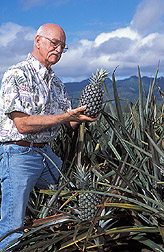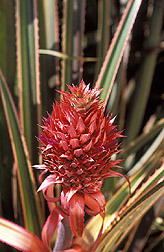Pineapples in Paradise
Uncovering Genetic Secrets of an Exotic Tropical Fruit
|
|
Despite fierce global competition, producers of pineapples at lush, scenic fields of the Hawaiian Islands have persevered. Hawaii’s sun-drenched pineapple farms yield more than 215 million pounds of fragrant, premium fruit each year, worth about $80 million to growers.
Native to South America, probably Paraguay or Brazil, pineapple was once a rare delicacy in northern climes. Today it’s plentiful, usually moderately priced, and always a great nutrition buy. It contains no fat or cholesterol, has very little sodium, and is high in vitamin C.
Whether you like it fresh, crushed, or juiced, this luscious tropical fruit is enormously popular. In fact, it’s America’s fifth favorite fruit: We each eat about 14 pounds of it every year!
But it’s not pineapple’s sweet taste or alluring aroma that has captured and held the attention of Agricultural Research Service scientists working in Hawaii. Instead, it’s pineapple genes. The investigators, assigned to the agency’s U.S. Pacific Basin Agricultural Research Center, are uncovering new details about the genetic richness, or diversity, of our planet’s pineapples.
|
|
Among the World’s Finest Pineapple Collections
Housed in Hilo on the island of Hawaii, America’s official collection—an assortment of nearly 200 pineapples and their relatives—is part of the ARS National Clonal Germplasm Repository for Tropical and Subtropical Fruit and Nut Crops.
ARS manages a nationwide network of such genebanks, which serve as living botanical libraries of crop plants and their rare or wild kin. These collections ensure that genes of these plants won’t be lost to insects, diseases, bulldozers, or other adversities.
Most of the ARS pineapple collection, among the world’s best, is a gift from Maui Pineapple Co., Ltd., Kahului, Maui. Its most unusual member might be the mini-pineapple Saigon Red, collected in 1938 in Vietnam. Though too tart to eat, its bright red skin and petite stature—sometimes just 5 inches high when fully grown—would make it a unique centerpiece accent at an elegant restaurant or in a cruise ship buffet.
A specimen known as Cheese Pine—collected in Guatemala in 1935—may be sweeter and richer in vitamin C than any other pineapple in the collection. And Pseudananas sagenarius, brought from the Rio Negro region of Argentina in 1938, always gets a second glance. Not a true pineapple, but a member of the same plant family nonetheless, P. sagenarius boasts a botanical quirk: The sharp, thornlike spines along its leaves arch away from the leaf tip instead of towards it. It’s an oddity that some experts are quick to notice.
|
|
Pineapples Have Fingerprints, Too
Working mostly with fruits from this extensive ARS genebank—plus some from privately owned collections—ARS investigators have developed definitive, DNA-based fingerprints to reliably establish who’s who among pineapples, or Ananas, of the world. These telltale stretches of DNA enable scientists and breeders to discern the relatedness of pineapples that are candidates for creating superior new plants.
Plant physiologist Paul H. Moore and horticulturist Francis T.P. Zee were part of the ARS research team whose studies yielded these DNA fingerprints, which have revealed that each pineapple in the collection is genetically unique.
Moore leads the ARS Tropical Plant Physiology, Disease, and Production Unit. He’s located in Aiea, about a 20-minute drive from downtown Honolulu on the island of Oahu. Colleague Zee is genebank curator and head of the ARS Tropical Plant Genetic Resource Management Unit, located in Hilo, on the rainy side of Hawaii Island.
Their fingerprinting study indicated that the ARS collection captures the diversity of pineapple’s genetic makeup and contains no unneeded duplicates. That’s true not only of the genetic wealth of leading cultivated varieties, such as an A. comosus called Smooth Cayenne—the kind you’re most likely to see at your supermarket, but also of pineapple’s lesser known cousins as well, such as the peculiar P. sagenarius, with its backward-pointing spines.
Superior Technology Reveals Diversity
DNA-based fingerprinting of plants isn’t new. But according to Moore, the pineapple project is probably the most comprehensive analysis yet reported that used a laboratory procedure known as AFLP, or amplified fragment length polymorphism.
The ARS researchers’ findings conflict with an earlier study that, using older technology, had indicated that the genetic base of pineapples in this genebank was narrow. The discrepancy may be explained by the fact that the newer AFLP technology is more sensitive than isozyme analysis, the approach used for the earlier work.
AFLP technology has proven ideal for defining an individual fingerprint for each pineapple in the collection. The AFLP genetic fingerprint of the wild, red-shell pineapple A. bracteatus, for example, is clearly different from that of other specimens at the genebank.
Moore and Zee did this genetic sleuthing with Cecilia Y. Kato, Chifumi Nagai, Denise L. Steiger, and Ray Ming of the grower-sponsored Hawaii Agriculture Research Center, Aiea; and Minna S. Kim of the University of Hawaii, Honolulu. The researchers documented their findings in a 2004 issue of Genetic Resources and Crop Evolution.
Their next step? To identify about 1,000 additional, telltale lengths of DNA. These are needed to sort out the relatedness of individual pineapples—information that further describes the scope of pineapple’s genepool. That research is already under way.
Why the need to protect pineapple’s genetic diversity? A genepool that is as diverse as possible helps secure pineapple’s future as a crop species. For instance, as-yet-unknown genes in the collection’s pineapples may hold the key to the plants’ ability to survive extreme drought (pineapples like dry weather, but there’s a limit to what they can handle) or to fend off attack by their worst natural enemies, such as mealybugs or microscopic worms called nematodes.
While all this work is going on, pineapple plants continue to flourish in paradise. Discoveries made by the Hawaii researchers should help ensure that this flavorful favorite will always have a place in the Hawaiian sun.—By Marcia Wood, Agricultural Research Service Information Staff.
This research is part of Plant, Microbial, and Insect Genetic Resources, Genomics, and Genetic Improvement, an ARS National Program (#301) described on the World Wide Web at www.nps.ars.usda.gov.
To reach scientists named in this article, contact Marcia Wood, USDA-ARS Information Staff, 5601 Sunnyside Ave., Beltsville, MD 20705; phone (301) 504-1662, fax (301) 504-1486.
"Pineapples in Paradise" was published in the October 2005 issue of Agricultural Research magazine.









